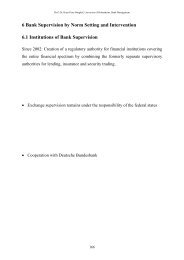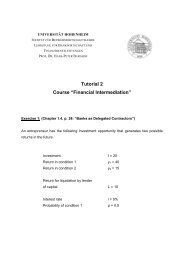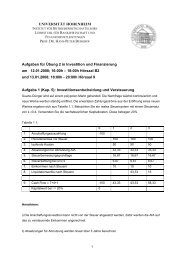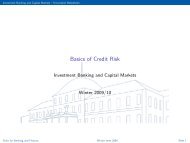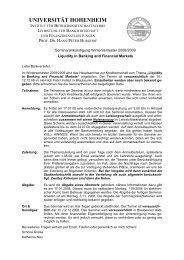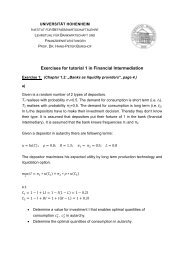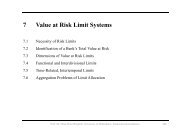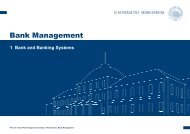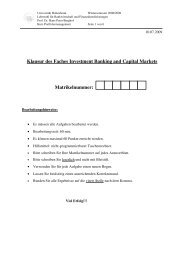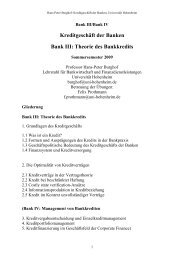7. Risks of Banking and Risk Mapping
7. Risks of Banking and Risk Mapping
7. Risks of Banking and Risk Mapping
You also want an ePaper? Increase the reach of your titles
YUMPU automatically turns print PDFs into web optimized ePapers that Google loves.
Pr<strong>of</strong>. Dr. Hans-Peter Burgh<strong>of</strong>, University <strong>of</strong> Hohenheim, Bank Management<br />
<strong>7.</strong> <strong><strong>Risk</strong>s</strong> <strong>of</strong> <strong>Banking</strong> <strong>and</strong> <strong>Risk</strong> <strong>Mapping</strong><br />
Banks face several risks:<br />
Credit risk<br />
Market price risk<br />
o Equity risk<br />
o Interest rate risk<br />
o Currency risk<br />
o Commodity risk<br />
Liquidity risk<br />
Operational risk (containing legal <strong>and</strong> political risk)<br />
Model risk<br />
Multiple objectives <strong>of</strong> risk measurement:<br />
Calculation <strong>of</strong> regulatory capital<br />
Calculation <strong>of</strong> economic capital<br />
Pr<strong>of</strong>it-oriented bank management under risk<br />
Role <strong>of</strong> the bank supervision regarding the risk management <strong>of</strong> banks?<br />
190
Pr<strong>of</strong>. Dr. Hans-Peter Burgh<strong>of</strong>, University <strong>of</strong> Hohenheim, Bank Management<br />
<strong>7.</strong>1 Pre-Commitment Approach<br />
Intention: Determination <strong>of</strong> a certain probability <strong>of</strong> failure F(..) for the bank<br />
without intense intervention<br />
Problem: asymmetric information about the earnings distribution<br />
Solution: “self-regulation“<br />
Bank estimates required equity herself<br />
If losses exceed this amount <strong>of</strong> capital the bank will be punished<br />
Implementation <strong>of</strong> F(..) using an incentive-compatible punishment<br />
Possible punishment:<br />
(i) Additional equity requirements in the next period<br />
(ii) Direct monetary penalty<br />
191
Pr<strong>of</strong>. Dr. Hans-Peter Burgh<strong>of</strong>, University <strong>of</strong> Hohenheim, Bank Management<br />
(i) Additional Equity Requirements<br />
Two points <strong>of</strong> time 0 <strong>and</strong> 1<br />
Vt<br />
V=V1–V0<br />
Value <strong>of</strong> the bank’s portfolio at time t<br />
Change in value <strong>of</strong> the bank’s portfolio<br />
f(V) Density function <strong>of</strong> the change in value<br />
F(V) Distribution function <strong>of</strong> the change in value<br />
r Discount rate (weighted average cost <strong>of</strong> capital)<br />
Intention: determine the amount <strong>of</strong> equity KT to implement F(V=-KT)<br />
Supervision can only observe r <strong>and</strong> sets F(V=-KT)<br />
192
Pr<strong>of</strong>. Dr. Hans-Peter Burgh<strong>of</strong>, University <strong>of</strong> Hohenheim, Bank Management<br />
Incentive-Compatible Punishment Function<br />
Losses that exceed KT<br />
Punishment -(V + KT)<br />
For every monetary unit <strong>of</strong> loss > KT the bank has to hold (additional)<br />
monetary units <strong>of</strong> equity in the next period<br />
Given F(V) Bank minimizes her capital expenditure:<br />
K<br />
T<br />
<br />
K T VKTf(<br />
V<br />
) dV<br />
1<br />
r<br />
<br />
First order condition (according to Leibniz rule):<br />
<br />
0 1<br />
1<br />
r<br />
K<br />
<br />
T<br />
<br />
1<br />
r<br />
F(<br />
V<br />
K<br />
f ( V<br />
) dV<br />
K<br />
T<br />
<br />
given F(<br />
K<br />
T ) <br />
T<br />
)<br />
<br />
f ( V<br />
) dV<br />
193
(ii) Direct Monetary Punishment<br />
Pr<strong>of</strong>. Dr. Hans-Peter Burgh<strong>of</strong>, University <strong>of</strong> Hohenheim, Bank Management<br />
R bank’s costs <strong>of</strong> equity, commonly known<br />
Losses that exceed KT<br />
Punishment -(V + KT)<br />
For every monetary unit <strong>of</strong> loss > KT the bank has to pay a fine <strong>of</strong> mone-<br />
tary units<br />
Given F(V)<br />
Bank minimizes the sum <strong>of</strong> cost <strong>of</strong> (equity) capital <strong>and</strong> expected fine:<br />
K<br />
T<br />
<br />
RK T VKTf( V<br />
) dV<br />
.<br />
1<br />
r<br />
<br />
First order condition (according to Leibniz rule):<br />
K<br />
T<br />
<br />
0 R f ( V<br />
) dV<br />
1<br />
r<br />
<br />
K<br />
T<br />
R1r<br />
<br />
given F(<br />
K<br />
) f ( V<br />
) dV<br />
.<br />
F(<br />
V<br />
K<br />
)<br />
T<br />
T<br />
<br />
<br />
194
Pr<strong>of</strong>. Dr. Hans-Peter Burgh<strong>of</strong>, University <strong>of</strong> Hohenheim, Bank Management<br />
Pros <strong>and</strong> Cons <strong>of</strong> the Pre-Commitment Approach<br />
Problem <strong>of</strong> asymmetric information is resolved<br />
Adequate to control divisions or partial portfolios<br />
Global bank regulation using the pre-commitment-approach?<br />
The punishment has to be credible<br />
Limited liability<br />
Multiple objectives <strong>of</strong> risk measurement:<br />
Calculation <strong>of</strong> regulatory capital<br />
Calculation <strong>of</strong> economic capital<br />
Pr<strong>of</strong>it-oriented bank management under risk<br />
Role <strong>of</strong> the bank supervision regarding the risk management <strong>of</strong> banks?<br />
195
Pr<strong>of</strong>. Dr. Hans-Peter Burgh<strong>of</strong>, University <strong>of</strong> Hohenheim, Bank Management<br />
<strong>7.</strong>2 Actual Supervisory Approach<br />
Bank Management <strong>and</strong> Bank Supervision Regarding <strong>Risk</strong> Management<br />
identified risks<br />
relevant risks<br />
measurable risks according<br />
to the state <strong>of</strong> technology<br />
measurement <strong>of</strong><br />
individual risks<br />
banking risks<br />
general supervision <strong>of</strong><br />
banking markets<br />
Bagatelle rules<br />
inclusion <strong>of</strong> new risks<br />
risk measuring requirements<br />
selection <strong>of</strong> the risk measurement<br />
method<br />
supervisory rules <strong>of</strong><br />
risk aggregation<br />
risk aggregation<br />
196<br />
unidentified risks<br />
negligible risks<br />
non-measurable risks<br />
measurement <strong>of</strong> the total<br />
measurable risk<br />
Potential for additional risk taking, requirement <strong>of</strong> risk reduction or <strong>of</strong> additional<br />
equity, sanctions <strong>of</strong> the bank supervision
Pr<strong>of</strong>. Dr. Hans-Peter Burgh<strong>of</strong>, University <strong>of</strong> Hohenheim, Bank Management<br />
Overview <strong>of</strong> <strong>Risk</strong> Measurement Methods According to Basel I/II<br />
Nontrading<br />
book<br />
institutions<br />
Trading<br />
book<br />
institutions<br />
<strong><strong>Risk</strong>s</strong> Captured positions method<br />
Default risks All risky assets (RB)<br />
Market price<br />
risks<br />
Operational<br />
<strong>Risk</strong><br />
Default risks<br />
(in the narrower<br />
sense)<br />
RH<br />
Market price<br />
risks<br />
Operational<br />
<strong>Risk</strong><br />
All foreign currency positions <strong>and</strong> raw materials<br />
positions (RH)<br />
Gross pr<strong>of</strong>it (all in all or split in business segments),<br />
damage data<br />
197<br />
St<strong>and</strong>ard approach<br />
or IRB<br />
approach (basis/advanced)<br />
St<strong>and</strong>ard approach<br />
or internal risk<br />
models<br />
Basic indicator<br />
approach, st<strong>and</strong>ard<br />
approach,<br />
advanced measurementapproach<br />
<strong>Risk</strong>y assets in the banking book (RB) St<strong>and</strong>ard approach<br />
or IRB<br />
<strong>Risk</strong>y<br />
positions<br />
in the trading<br />
book<br />
Italic: Significant changes due to Basel II<br />
Default risks in the banking book<br />
Interest (net<br />
positions)<br />
Stocks (net<br />
positions)<br />
General price risk<br />
Specific price risk<br />
General price risk<br />
Specific price risk<br />
Foreign currency positions <strong>and</strong> raw material positions<br />
in the banking book <strong>and</strong> trading book<br />
Gross pr<strong>of</strong>it (all in all or split in business segments),<br />
damage data<br />
approach (basis/advanced)<br />
St<strong>and</strong>ard approach<br />
or internal risk<br />
models<br />
Basic indicator<br />
approach, st<strong>and</strong>ard<br />
approach,<br />
advanced measurementapproach
Pr<strong>of</strong>. Dr. Hans-Peter Burgh<strong>of</strong>, University <strong>of</strong> Hohenheim, Bank Management<br />
a) St<strong>and</strong>ard Procedure I: Gearing Ratios for Credit <strong><strong>Risk</strong>s</strong><br />
Default <strong>Risk</strong> in the <strong>Banking</strong> Book<br />
Proceedings:<br />
1. Calculation <strong>of</strong> the assessment basis<br />
Book value, market value<br />
2. Charge rate subject to the expected availment<br />
Globally, for derivatives: market valuation method or duration method<br />
3. Weights <strong>of</strong> credit ranking<br />
St<strong>and</strong>ard approach: 5 credit ranking classes according to classification: 0%, 20%,<br />
50%, 100%, 150%<br />
(Different weights for special securities or securitizations)<br />
198
<strong>Risk</strong> Weights for Default <strong>Risk</strong><br />
St<strong>and</strong>ard approach:<br />
<strong>Risk</strong> weights according to external ratings<br />
Pr<strong>of</strong>. Dr. Hans-Peter Burgh<strong>of</strong>, University <strong>of</strong> Hohenheim, Bank Management<br />
AAA –<br />
AA-<br />
A+ – A- BBB+ –<br />
BBB-<br />
199<br />
External Rating<br />
BB+ –<br />
BB-<br />
B+ – B-<br />
Less<br />
than B-<br />
without<br />
rating<br />
States 0% 20% 50% 100% 100% 150% 100%<br />
Banks option 1 20% 50% 100% 100% 100% 150% 100%<br />
Banks option 2<br />
(short term)<br />
20%<br />
20%<br />
50%<br />
20%<br />
50%<br />
20%<br />
100%<br />
50%<br />
100%<br />
50%<br />
150%<br />
150%<br />
50%<br />
20%<br />
Companies 20% 50% 100% 100% 150% 150% 100%<br />
(Banks option 1: one category worse than the home country)<br />
Problems:<br />
Effects <strong>of</strong> diversification<br />
Independence <strong>of</strong> rating agencies<br />
Internal ratings<br />
IRB approach: <strong>Risk</strong> weights as a function <strong>of</strong> default probability <strong>and</strong> other factors
Pr<strong>of</strong>. Dr. Hans-Peter Burgh<strong>of</strong>, University <strong>of</strong> Hohenheim, Bank Management<br />
b) St<strong>and</strong>ard Procedure II: Building-Block-Approach<br />
Positions with interest rate risks<br />
<strong>Risk</strong> categories:<br />
Special price risk (idiosyncratic risk)<br />
Weighting factors:<br />
Central states: Special additions to the capital requirement differentiated by duration<br />
<strong>and</strong> risk categories for rating classes (0% AAA to AA-, 0,25% to 1,60% for A+ to<br />
BBB-, 8% otherwise),<br />
High quality assets:<br />
Up to 6 months 3,125%, 6 months to 2 years 12,5%, more than 2 years 20%.<br />
Other assets: 100%<br />
General price risk (systematic/market risk)<br />
Calculating using maturity method or duration method<br />
200
Maturity Method<br />
Pr<strong>of</strong>. Dr. Hans-Peter Burgh<strong>of</strong>, University <strong>of</strong> Hohenheim, Bank Management<br />
Weights <strong>of</strong> closed positions in time b<strong>and</strong>s <strong>and</strong> zones for maturity method:<br />
Zone/<br />
B<strong>and</strong><br />
Weight<br />
(in %)<br />
I/1 -1M 0% 10%<br />
I/2 -3M 0,2% 10%<br />
I/3 -6M 0,4% 10%<br />
I/4 -1J 0,7% 10%<br />
II/1 -2J 1,25% 10%<br />
II/2 -3J 1,75% 10%<br />
II/3 -4J 2,25% 10%<br />
III/1 -5J 2,75% 10%<br />
…<br />
III/6 >20J 6% 10%<br />
Weight <strong>of</strong> the closed positions<br />
B<strong>and</strong> Zone Zone I/II<br />
40%<br />
30%<br />
30%<br />
201<br />
40%<br />
Zone<br />
II/III<br />
40%<br />
Zone I/III<br />
Open<br />
positions<br />
150% 100%
Duration Method<br />
Macaulay Duration:<br />
T = Maturity <strong>of</strong> the security<br />
P = Present value <strong>of</strong> the security<br />
Pr<strong>of</strong>. Dr. Hans-Peter Burgh<strong>of</strong>, University <strong>of</strong> Hohenheim, Bank Management<br />
yt = Cash flow <strong>of</strong> the security at time t<br />
i = Internal rate <strong>of</strong> return<br />
D <br />
T<br />
<br />
t1<br />
T<br />
<br />
t1<br />
ty<br />
t<br />
t 1i y<br />
t<br />
1i t<br />
<br />
1<br />
P<br />
T<br />
<br />
t1<br />
ty<br />
t<br />
t 1i Marginal interest sensitivity <strong>of</strong> the present value:<br />
P<br />
<br />
i<br />
y<br />
t 1<br />
,<br />
T<br />
T<br />
t t t DP D<br />
P<br />
t1<br />
t<br />
mod<br />
t1<br />
1i 1 i t1<br />
1i 1 i<br />
y<br />
202<br />
1
Pr<strong>of</strong>. Dr. Hans-Peter Burgh<strong>of</strong>, University <strong>of</strong> Hohenheim, Bank Management<br />
Weights <strong>of</strong> closed positions in time b<strong>and</strong>s <strong>and</strong> zones for duration method:<br />
Zone/<br />
B<strong>and</strong><br />
Change<br />
<strong>of</strong> return<br />
(in %)<br />
I/1 -1M 1.0% 5%<br />
I/2 -3M 1.0% 5%<br />
I/3 -6M 1.0% 5%<br />
I/4 -12M 1.0% 5%<br />
II/1 -1.9J 0.9% 5%<br />
II/2 -2.8J 0.8% 5%<br />
II/3 -3.6J 0.75% 5%<br />
III/1 -43J 0.75% 5%<br />
…<br />
III/8 >20J 0.6% 5%<br />
Weight <strong>of</strong> the closed positions<br />
B<strong>and</strong> Zone Zone I/II<br />
40%<br />
30%<br />
30%<br />
203<br />
40%<br />
Zone<br />
II/III<br />
40%<br />
Zone I/III<br />
Open<br />
positions<br />
150% 100%
Pr<strong>of</strong>. Dr. Hans-Peter Burgh<strong>of</strong>, University <strong>of</strong> Hohenheim, Bank Management<br />
Internal Models <strong>and</strong> Value at <strong>Risk</strong><br />
Qualitative specifications:<br />
1. Work organization <strong>and</strong> process organization<br />
2. <strong>Risk</strong> controlling<br />
3. Documentation<br />
4. Continuous check <strong>of</strong> the risk models<br />
5. Calculation <strong>of</strong> crisis scenarios<br />
6. Daily limitation <strong>of</strong> risk<br />
<strong>7.</strong> Updated historical data base<br />
8. Annual inspection by the internal audit<br />
9. Responsibility <strong>of</strong> the management<br />
204
Pr<strong>of</strong>. Dr. Hans-Peter Burgh<strong>of</strong>, University <strong>of</strong> Hohenheim, Bank Management<br />
Quantitative <strong>and</strong> Methodical Specifications:<br />
3. Value at <strong>Risk</strong><br />
St<strong>and</strong>ardization <strong>of</strong> the lower partial moment <strong>of</strong> 0 th order<br />
K<br />
<br />
<br />
Ky n<br />
LPM ( n,<br />
K)<br />
df ( y)<br />
, with n = 0<br />
LPM ( 0,<br />
K)<br />
F(<br />
y K)<br />
Confidence level<br />
K = VaR<br />
2. Confidence level 99%, holding period 10 days<br />
3. Global triplication <strong>of</strong> the required equity<br />
y = Difference between the actual terminal value<br />
<strong>of</strong> the portfolio <strong>and</strong> the terminal value <strong>of</strong><br />
the previous period<br />
VaR (p)<br />
(Confidence<br />
level <strong>of</strong> p<br />
percent)<br />
3VaR (p) = VaR (q) (Confidence level <strong>of</strong> q<br />
percent)<br />
205<br />
y=0<br />
f(y)<br />
y
Feedback through Backtesting:<br />
Pr<strong>of</strong>. Dr. Hans-Peter Burgh<strong>of</strong>, University <strong>of</strong> Hohenheim, Bank Management<br />
Backtesting<br />
Period under review: 250 business days<br />
Number <strong>of</strong> overshoots (in %) Additional factor<br />
< 5 ( 9 (> 4%) 1<br />
206
Literature for Chapters 7<br />
Pr<strong>of</strong>. Dr. Hans-Peter Burgh<strong>of</strong>, University <strong>of</strong> Hohenheim, Bank Management<br />
Burgh<strong>of</strong>/Henke (2000): Kreditderivate und Bankenaufsicht – Entwicklungen und Perspektiven<br />
in Deutschl<strong>and</strong> und international, in: Burgh<strong>of</strong> et al. (Hrsg.): Kreditderivate.<br />
Hartmann-Wendels/Pfingsten/Weber (2000): Bankbetriebslehre,<br />
insbes. Kapitel H, I.<br />
Krümmel (1989): Unternehmenspolitische Vorgaben für die Risikosteuerung der Bank, in:<br />
Krümmel/Rudolph (Hrsg.):Finanzintermediation und Risikomanagement.<br />
Schierenbeck (2001): Ertragsorientiertes Bankmanagement.<br />
207



